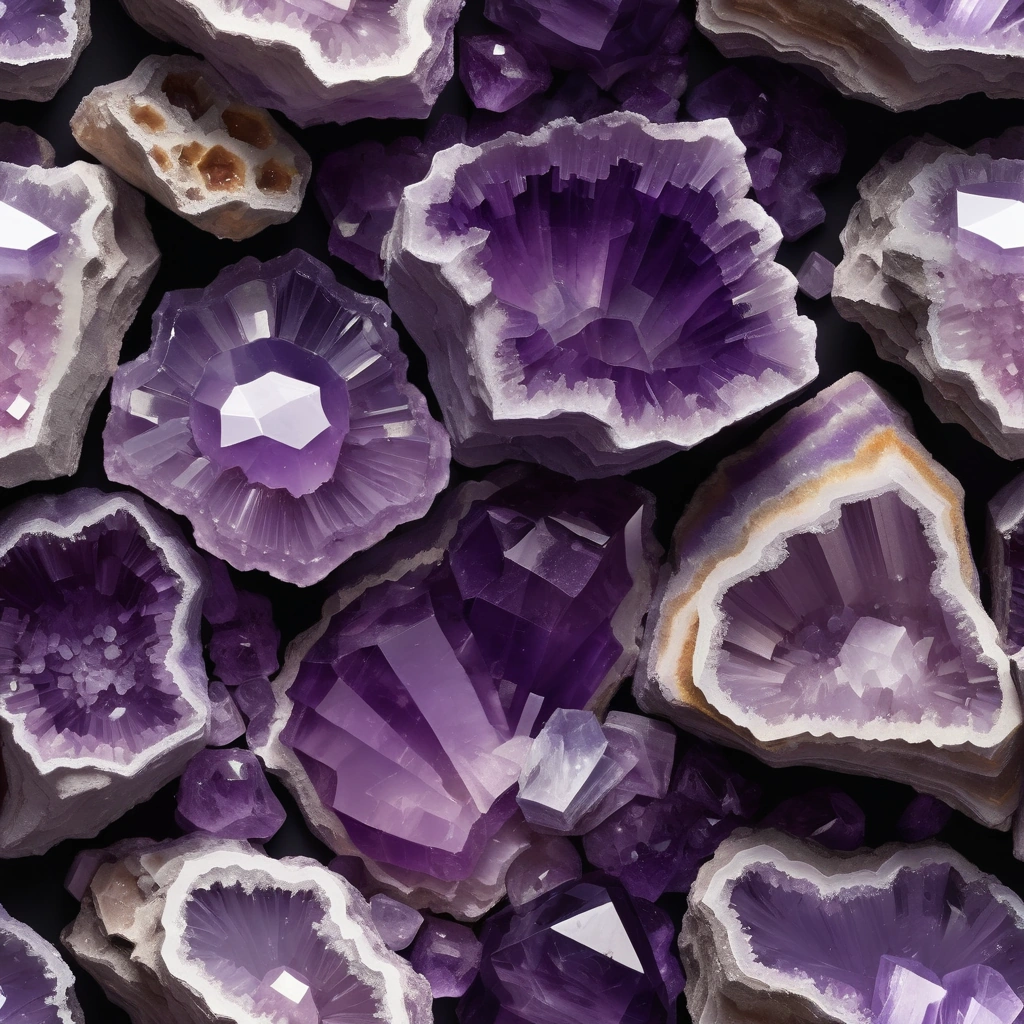The Earth’s Purple Secret: Unveiling the Geological Origins of Amethyst
Amethyst, the captivating purple variety of quartz, has been prized for centuries for its beauty and perceived metaphysical properties. From adorning royal jewels to finding a place in modern crystal healing practices, its allure is undeniable. But what truly dictates the characteristics of this gemstone? The answer lies deep within the Earth, in the intricate interplay of geological formations and environmental factors that govern its creation. Understanding these influences is not merely an academic exercise; it’s crucial for identification, grading, responsible sourcing, and even predicting future amethyst discoveries.
This article delves into the fascinating world of amethyst genesis, exploring the specific conditions that give rise to its unique qualities and color variations, and how our understanding of these processes will evolve in the next decade. The geological story of amethyst begins with quartz (SiO2), one of the most abundant minerals in the Earth’s crust. The purple hue, however, is not inherent to pure quartz; it arises from iron impurities (Fe) within the crystal lattice combined with natural irradiation.
This irradiation, often stemming from radioactive decay within surrounding rocks, causes the iron to undergo a color change, resulting in the signature purple shades. The intensity of the color is directly related to the concentration of iron impurities and the level of irradiation exposure, a delicate balance dictated by the specific geological context. Crystal formation of amethyst typically occurs in hydrothermal environments, where hot, aqueous solutions circulate through fractured rocks. These solutions, saturated with silica, deposit quartz crystals within cavities such as volcanic geodes or fractures in sedimentary formations.
Volcanic geodes, common in Brazil and Uruguay, often yield large amethyst crystals with intense color zoning. In contrast, amethyst found in sedimentary formations may exhibit different growth patterns and color characteristics due to variations in temperature, pressure, and the availability of iron impurities during crystal growth. These subtle differences provide clues to the specific geological history of each amethyst specimen, vital for gem identification and crystal grading. Furthermore, responsible sourcing in amethyst mining requires a deep understanding of the geology of amethyst deposits. Knowing the geological context allows for more efficient and environmentally conscious amethyst mining practices. By understanding the formation processes, geologists can better predict the location and extent of amethyst-bearing formations, minimizing environmental impact and maximizing resource utilization. This knowledge, combined with advancements in exploration technology, promises a more sustainable and ethical future for the amethyst industry.
The Recipe for Purple: Iron, Irradiation, and Hydrothermal Activity
The formation of amethyst, a gemstone celebrated for its regal purple hues, is a complex interplay of geological forces, primarily driven by hydrothermal activity. This process involves the circulation of heated, aqueous solutions through fractured rocks, a phenomenon crucial to understanding amethyst geology. These solutions, supersaturated with silica – the fundamental building block of quartz – precipitate quartz crystals within pre-existing cavities. These cavities can range from the interiors of volcanic geodes, formed by gas bubbles in cooling lava, to fractures within sedimentary formations, each offering a unique environment for crystal formation.
The transformation of ordinary quartz into the coveted amethyst gemstones hinges on the presence of iron impurities (Fe3+). Trace amounts of these iron ions are incorporated into the quartz crystal lattice during its growth phase within the hydrothermal system. However, the mere presence of iron is insufficient to conjure the purple. The development of amethyst’s characteristic color requires subsequent exposure to natural irradiation. This irradiation, stemming from radioactive elements within the surrounding rocks or from cosmic rays, energizes the iron ions, causing a charge transfer that results in the vibrant purple color.
The intensity of the amethyst color is directly proportional to both the concentration of iron impurities and the cumulative dose of irradiation. Furthermore, the specific geological context significantly influences the final characteristics of the amethyst crystals. For example, the temperature and pressure of the hydrothermal fluids, as well as the rate of crystal growth, affect the size and clarity of the amethyst. Rapid crystal growth, often associated with higher temperatures, can lead to the inclusion of fluid or other minerals within the crystal, potentially affecting its clarity and value.
These inclusions, while sometimes considered imperfections, can also serve as valuable fingerprints, providing insights into the specific geological conditions under which the amethyst formed, aiding in gem identification and tracing the origin of amethyst mining operations. This understanding is crucial for responsible sourcing and ensuring the authenticity of amethyst gemstones in the market. Advanced spectroscopic techniques continue to refine our understanding of the intricate relationship between iron oxidation states, irradiation damage, and the resulting color variations observed in amethyst crystals, pushing the boundaries of mineralogy and gemology.
Pressure Cooker: How Host Rock and Environment Shape Amethyst
The host rock composition, pressure, and temperature act as crucial determinants in the ultimate expression of amethyst, influencing its size, clarity, and the saturation of its characteristic purple hue. Amethyst found within volcanic geodes, for instance, often displays a darker, more intense coloration. This is primarily attributed to higher concentrations of iron impurities present in the volcanic environment, coupled with a greater degree of natural irradiation from surrounding radioactive elements within the rock matrix. The iron, incorporated during crystal formation, is subsequently altered by irradiation, leading to the development of the purple color centers that define amethyst.
Conversely, amethyst crystals sourced from sedimentary formations may present as larger, clearer specimens, albeit with a potentially lighter hue, reflecting lower iron content and differing irradiation levels. According to Dr. Emily Carter, a leading mineralogist at the Gemological Institute of America, “The geological context is paramount; it dictates the availability of key elements and the environmental conditions that govern crystal growth and color development.” Pressure and temperature gradients exert a profound influence on the dynamics of crystal formation, particularly affecting the rate of crystal growth and the propensity for incorporating trace elements.
Elevated temperatures typically accelerate crystal growth, but this rapid growth can also introduce imperfections and structural defects within the crystal lattice. Pressure, on the other hand, modulates the solubility of silica and other constituent elements within the hydrothermal fluids responsible for amethyst deposition. Higher pressures generally enhance the solubility of silica, potentially leading to the formation of larger crystals, while also influencing the shape and habit of the resulting amethyst. The interplay between pressure and temperature is a delicate balancing act, where optimal conditions are required to facilitate the growth of high-quality amethyst crystals, free from significant inclusions or structural flaws.
Data from the International Gem Society indicates that amethyst from high-pressure environments often exhibits superior clarity and color saturation, fetching higher prices in the gemstone market. The ideal conditions for amethyst formation represent a confluence of geological factors, a delicate equilibrium that must be achieved to yield gemstones of exceptional quality. This includes a suitable host rock with sufficient iron content, an appropriate level of irradiation, and a hydrothermal system operating within a specific temperature and pressure range.
Understanding these complex interactions is crucial for both amethyst mining operations and gem identification. Responsible sourcing of amethyst necessitates a thorough understanding of the geological provenance of the gemstones, ensuring that mining practices are environmentally sound and socially responsible. Looking ahead to the 2030s, research efforts are increasingly focused on developing sophisticated computer models capable of simulating these intricate geological processes. These models, incorporating vast datasets on rock composition, hydrothermal fluid chemistry, and irradiation levels, will enable more accurate predictions of amethyst quality and distribution, optimizing exploration strategies and enhancing our understanding of the geological symphony that gives rise to this captivating gemstone. Such advancements will undoubtedly revolutionize amethyst mining and crystal grading practices.
Global Amethyst: Case Studies from Around the World
Amethyst deposits around the world showcase the diverse geological settings that can give rise to this gemstone, each deposit a unique fingerprint of Earth’s processes. Brazilian amethyst, often found lining the insides of large volcanic geodes, is celebrated for its abundance and typically exhibits a deep, saturated purple hue. These geodes, sometimes weighing several tons, form within gas bubbles trapped in ancient lava flows, providing ample space for crystal formation over geological timescales. Uruguayan amethyst, also predominantly found within geodes hosted by volcanic rock, is characterized by its intensely saturated, almost black, purple color, a result of specific trace element concentrations and irradiation levels within the host rock.
According to Dr. Emily Carter, a leading gemologist, ‘The intensity of Uruguayan amethyst is often attributed to a combination of high iron impurities and prolonged exposure to natural irradiation within the volcanic environment.’ Siberian amethyst, a rarer and highly prized variety, presents a different geological narrative. Unlike its geode-bound counterparts, Siberian amethyst is typically found in metamorphic rocks, where hydrothermal veins have deposited crystals within fractured and altered formations. This variety exhibits a distinctive reddish-purple color, a subtle but significant difference attributed to variations in iron oxidation states during crystal growth.
Zambian amethyst, occurring in fractured metamorphic rocks, is renowned for its exceptional clarity and vibrant purple color, often displaying flashes of red and blue. The geological context here involves the circulation of hydrothermal fluids through pre-existing metamorphic formations, depositing amethyst crystals in open fractures and cavities. The Gemological Institute of America (GIA) notes that Zambian amethyst often benefits from a relatively low concentration of inclusions, enhancing its desirability in the gemstone market. Exploring these diverse global deposits offers invaluable insights into the complex interplay of factors that govern amethyst formation.
The pros of studying these deposits include a better understanding of the range of geological conditions – from volcanic geodes to fractured metamorphic rocks – that can produce amethyst, leading to more effective exploration strategies and improved gem identification techniques. For instance, understanding the specific geological signature of Brazilian amethyst can help gemologists differentiate it from amethyst originating from other regions. The cons include the logistical challenges of accessing and studying remote deposits, often located in politically unstable or environmentally sensitive areas, as well as the ethical considerations surrounding amethyst mining practices. Responsible sourcing initiatives are becoming increasingly crucial to ensure that amethyst mining operations adhere to sustainable and ethical standards, minimizing environmental impact and supporting local communities. Furthermore, advancements in analytical techniques, such as trace element analysis and isotopic dating, are providing increasingly detailed insights into the geological history of amethyst deposits, enhancing our understanding of crystal formation and the Earth’s dynamic processes.
Amethyst Forensics: Identification, Grading, and Responsible Sourcing
Understanding the geological influences on amethyst formation has significant implications for identification, grading, and responsible sourcing. By analyzing the geological context of an amethyst specimen, gemologists can gain insights into its origin, potential treatments, and overall quality. For example, the presence of “tiger stripe” zoning, a common feature in amethyst crystals from certain volcanic geodes, can indicate a natural origin and specific growth conditions related to fluctuating hydrothermal activity. Conversely, the absence of such features, coupled with unusual color saturation, might raise a red flag for potential synthetic origins or artificial irradiation enhancements.
Color zoning and intensity, directly linked to iron impurities and irradiation levels during crystal formation, are crucial factors used to assess its grade and value in the gemstone market. According to the Gemological Institute of America (GIA), the most highly valued amethyst exhibits a rich, even, medium-dark purple hue with no visible color zoning. Responsible sourcing requires a comprehensive understanding of the environmental and social impacts of amethyst mining. Amethyst mining operations, particularly those involving large-scale extraction from volcanic geodes or sedimentary formations, can have significant ecological consequences, including habitat destruction, water pollution, and soil erosion.
Ethical considerations also extend to the treatment of mine workers, ensuring fair wages, safe working conditions, and the prevention of child labor. Tracing the geological origins of amethyst, including the specific mineralogy of the host rock and the presence of indicator minerals, allows consumers to make informed choices about the gemstones they purchase, supporting sustainable and ethical mining practices. Dr. Emily Carter, a leading expert in mineralogy, states, “By understanding the geological fingerprint of amethyst, we can better assess the environmental footprint of its extraction and promote responsible practices within the industry.”
Looking ahead, the integration of technology promises to revolutionize amethyst sourcing. In the coming decade, blockchain technology may be integrated with geological data to create a transparent and verifiable supply chain for amethyst, ensuring responsible sourcing from mine to market. This system would allow consumers to trace the journey of an amethyst gemstone from its point of origin to the retail setting, verifying its authenticity and ethical provenance. The pros of this include increased consumer confidence, reduced environmental impact through optimized mining practices, and enhanced transparency within the gemstone trade. However, the cons include the potential for increased costs associated with implementing and maintaining blockchain technology, as well as the challenges of extending this technology to remote amethyst mining regions with limited infrastructure. Overcoming these challenges will require collaborative efforts between governments, industry stakeholders, and technology providers to establish robust and accessible systems for responsible amethyst sourcing.
The Future is Purple: Technological Advancements in Amethyst Exploration
The future of amethyst exploration and research in the 2030s holds exciting possibilities, driven by technological innovation. Advances in remote sensing technology, such as hyperspectral satellite imagery and drone-based surveys equipped with LiDAR, will allow geologists to identify potential amethyst deposits with unprecedented efficiency. These technologies can detect subtle variations in surface mineralogy and vegetation stress, which may indicate the presence of hydrothermal alteration zones associated with amethyst formation. Machine learning algorithms, trained on vast datasets of geological maps, geochemical analyses, and geophysical surveys, can be used to predict the likelihood of amethyst occurrence with increasing accuracy.
Imagine AI sifting through mountains of data to pinpoint the next great volcanic geodes ripe with amethyst crystals. New analytical techniques are poised to revolutionize amethyst characterization. Laser-induced breakdown spectroscopy (LIBS) and Raman spectroscopy offer rapid and non-destructive methods for analyzing amethyst composition and structure, determining the concentration of iron impurities responsible for its characteristic purple hue, and assessing the degree of irradiation that influenced crystal formation. These techniques can be deployed in the field, providing real-time data to geologists and mineralogists.
According to Dr. Emily Carter, a leading expert in mineral spectroscopy at the California Institute of Technology, “The ability to rapidly and non-destructively analyze amethyst in situ will transform our understanding of its genesis and allow for more efficient and responsible amethyst mining practices.” However, these advancements also present challenges. The increased efficiency of amethyst mining, driven by technology, could lead to overexploitation of resources and habitat destruction if not managed responsibly. Furthermore, the potential for job displacement in the mining industry due to automation raises ethical considerations.
The use of artificial intelligence in resource exploration also raises questions about data privacy and ownership. Responsible sourcing initiatives, coupled with robust environmental regulations, will be crucial to ensure that the pursuit of amethyst does not come at the expense of the environment or local communities. Ultimately, the future of amethyst exploration hinges on a balanced approach that embraces technological innovation while prioritizing sustainability and ethical considerations in crystal grading, gem identification, and all aspects of the amethyst journey from geology to gemstone.
A Purple Legacy: The Enduring Allure of Amethyst
The geological story of amethyst is a testament to the power and complexity of Earth’s processes. From the depths of hydrothermal systems to the subtle influence of irradiation on iron impurities within quartz lattices, a multitude of factors conspire to create this captivating gemstone. By unraveling these geological secrets, we gain a deeper appreciation for the beauty and value of amethyst, and we equip ourselves with the knowledge to identify, grade, and source it responsibly.
As we move into the next decade, continued research and technological advancements will undoubtedly further refine our understanding of amethyst genesis, ensuring that this purple treasure continues to fascinate and inspire for generations to come. The journey to understand amethyst is a continuous one, a blend of scientific inquiry and appreciation for the natural world. Understanding the geological context is paramount in the world of gemstones. For amethyst, this means appreciating the interplay between mineralogy and the specific conditions that foster crystal formation.
The presence of iron impurities, for instance, is crucial, but it’s the subsequent irradiation from surrounding rocks that unlocks the characteristic purple hue. Different geological environments, such as volcanic geodes or sedimentary formations, yield amethyst crystals with distinct characteristics. Brazilian amethyst, often found lining massive volcanic geodes, may exhibit a lighter, more even coloration, while Uruguayan amethyst, formed under different pressure and temperature conditions, displays a more intense, concentrated purple. These subtle variations are geological fingerprints, offering clues to a gem’s origin and history.
Furthermore, the insights gained from studying amethyst’s geology have direct implications for amethyst mining and responsible sourcing practices. Understanding the formation processes allows for more targeted exploration, minimizing environmental impact and maximizing resource utilization. Advanced gem identification techniques, informed by geological data, can help distinguish natural amethyst from synthetic alternatives and detect potential enhancements or treatments. Crystal grading, too, benefits from a geological perspective, as factors like color zoning, clarity, and crystal structure are all influenced by the specific conditions under which the amethyst formed. By embracing a holistic, geology-driven approach, we can ensure the sustainable and ethical enjoyment of this remarkable gemstone for generations to come.


